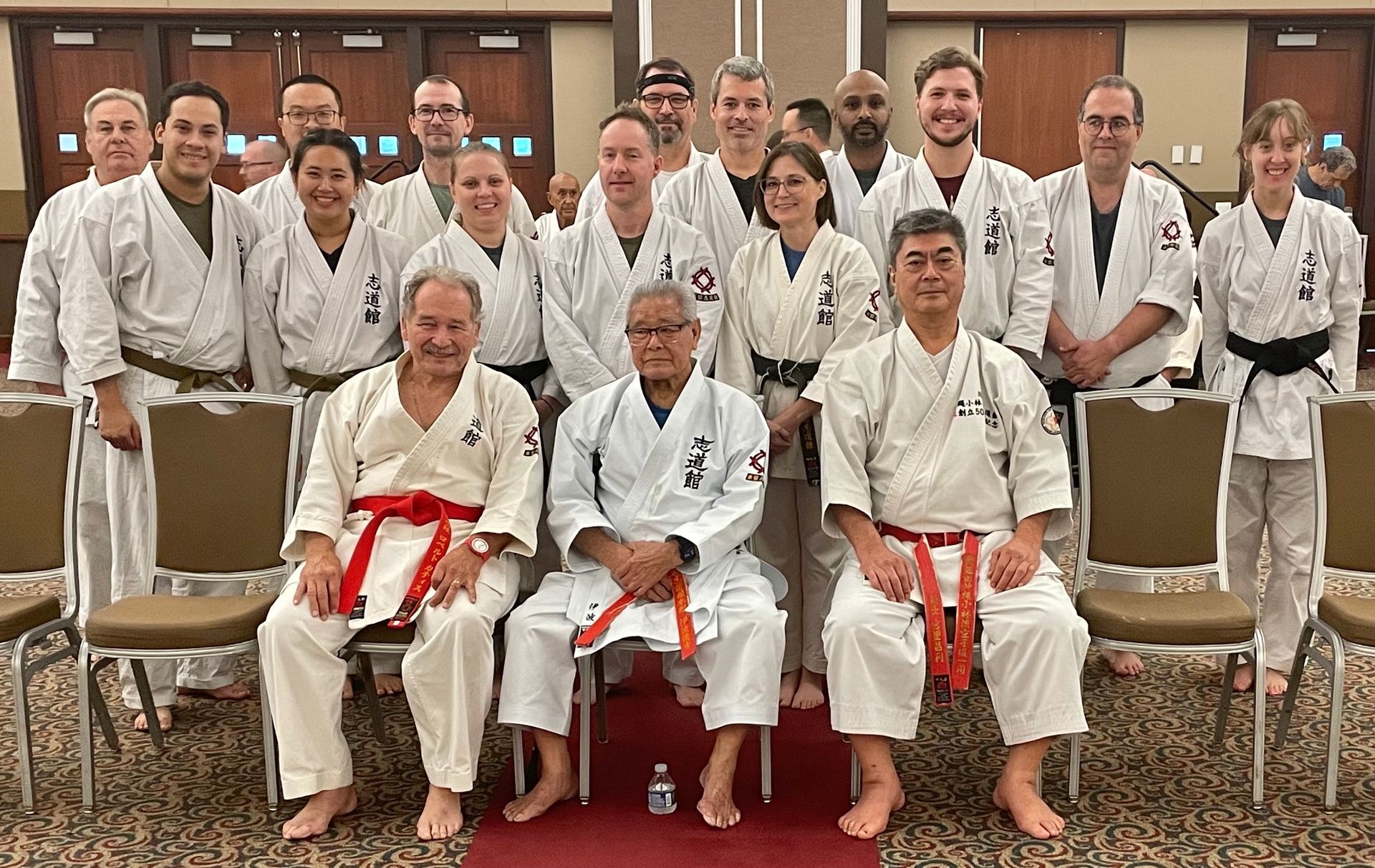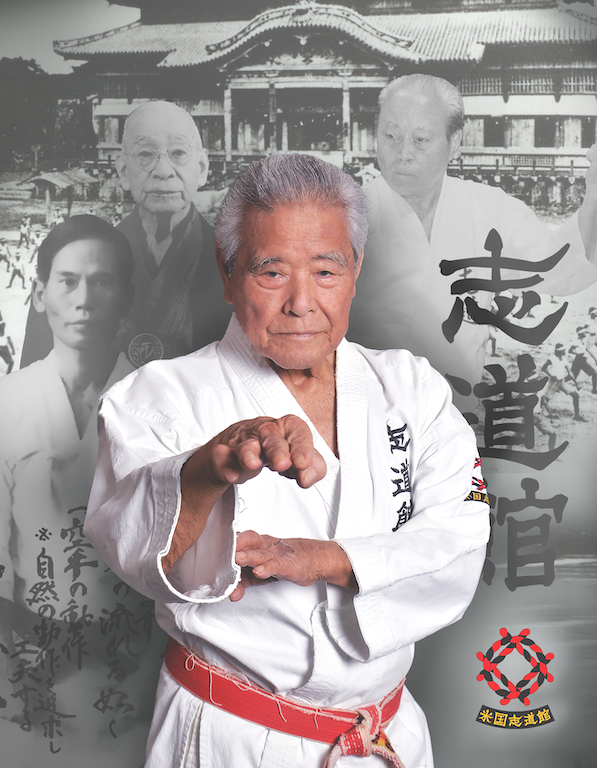Sensei Iha said, "Okinawan Kata is like an onion"
- By Robert Roberto Curtis, 9th Dan, Shoirn Ryu Beikoku Shidokan Karate
- •
- 20 Oct, 2024
- •
The more you peel onion layers back, the more you find.

Sensei's comment that Shorin Ryu Shidokan "Kata is like an onion" has taken me decades to understand. If it confuses you don't worry. We'll work on these concepts so you understand them.
Now looking back on Sensei's initial teachings of these three levels of Shorin Ryu Karate kata it all makes sense. Well, the concepts make sense. I still need to work on the applications.
I understand better what Sensei Iha meant when he said that Shorin Ryu Karate kata was like an onion. As you peel back layers you would discover something new.
- I trained in Judo before meeting Sensei Iha. He enjoyed practicing the throws found in kata on me. He would often perform up to 10 different throws on me from the same middle punch. When he found a throw that didn't work as well as he expected, he would modify his repsonse to improve it. I discovered that most on-lookers only saw that he was throwing me, not the various applications he was using to do so.
- In 1989 while visiting Sensei Iha while on home-leave from an assignment in Chile he discovered I was teaching karate to the US Marines, and others, who needed/used karate for self defense and life preservation. He said everyone learns the punch, kick & block basics in karate kata and that is all that most people need.
He said, “Practice as if there are no blocks in kata!” What! He said, "Now do kata with no blocks and you will find the self defense applications!" Then he did soto uke on my punching arm elbow while trapping my punch in hikete. He then trapped my punching arm in hikete and performed uchi uke (cross block) followed by gedan barai (down block) from Kihon Kata 2. Each time I thought he’d snap my arm. We all marveled whenever he showed us these moves over and over on videos, at NTS, at seminars, etc. He showed us but we never trained in them. Suddenly, he was showing me how to use the blocking arm as the attacking arm for self defense.
For the next 8 years, I focused on modifying my kata block applications to strikes. I think I may have finally completed that task to modify most all kata blocks into strikes/attacks about 40 years later.
- In 1997 in preparation for my assignment to Italy, and eventually Austria, he said now do kata with no punches, kicks, or blocks. I was visibly confused by this concept. So he grabbed me with both hands and threw me to the ground with the first turn and soto uke block of kihon kata 4.
As I stood up, he grabbed me and did it again, but I contentedly resisted falling this time so he stepped forward and used the hikete motion to trap my arm and used the punching motion as a palm heel on my shoulder to throw me.
Then we started again, I smugly resisted falling the first two moves. I thought I had him! He then hooked his arm under mine and did the 180 degree turn nearly separating my arm from my body and then stepped forward and threw me with a punching motion. He pointed out that this grappling/throwing moves only when you turn your base foot and place it in position first, then turn your hips, then hands. No spin. “See?”, he said, “now you do.”
- During the first NTS and seminars he used to focus on first planting the base foot, usually the back foot, for the Kihon and Pinan katas. As more sport karate focused dojos increased his focus on "no spinning turns" greatly diminished. At one seminar, I watched as students focused on tournaments questioned him over and over about the 270-degree spin in Kihon and Pinan katas. They would demonstrate their spin and ask him, "should I do it this way, or this way?" Sensei Iha was clearly uninterested. Finally, Sensei said, “pretty good” and we started the seminar again.
As the seminar began again, I performed the spinning turn in Kihon Kata 4 others had just demonstrated to him. He asked, “why you do?” I said you just told them. He said, “That for them. Not for you!” I was stunned and confused. It took me forever to realize that he was teaching me effective self defense karate because of my students' needs while he was teaching sport karate or the punch-kick-block karate to others. Many times he would show or demonstrate kata moves or applications and then tell me, "not you!" I didn't understand.
Being suck a quick learner, It only took me a decade or so, to realize that there was a big difference between Iha's self defense focused karate he was teaching me (because of my students) and sport karate. Setting your base foot, moving your hip, and then your hands (Fo-Hi-Ha) once again rises to the top for self defense because if you grapple with sport karate spinning moves you wind up on the ground or very off balance. It looks pretty to win a trophy, yet it doesn't work for self defense grappling.
So I have spent 20+ years trying to understand how to apply each move in kata for grappling. I understand now how Kata is compared to stand up jiu jitsu.
Streetfighters always laugh at karate and martial arts focus on kicking and punching (dancing in white pajamas, they say) because in a fight you might get only one chance for a kick or punch and then you are grappling by pulling, pushing, grabbing, and throwing. Yet focusing on, and practicing Fo-Hi-Ha movements with partners makes your karate self defense effective.
I often wonder what Sensei might have shown me if I had another overseas assignment!
Now looking back on Sensei's initial teachings of these three levels of Shorin Ryu Karate kata it all makes sense. Well, the concepts make sense. I still need to work on the applications.
I understand better what Sensei Iha meant when he said that Shorin Ryu Karate kata was like an onion. As you peel back layers you would discover something new.
- I trained in Judo before meeting Sensei Iha. He enjoyed practicing the throws found in kata on me. He would often perform up to 10 different throws on me from the same middle punch. When he found a throw that didn't work as well as he expected, he would modify his repsonse to improve it. I discovered that most on-lookers only saw that he was throwing me, not the various applications he was using to do so.
- In 1989 while visiting Sensei Iha while on home-leave from an assignment in Chile he discovered I was teaching karate to the US Marines, and others, who needed/used karate for self defense and life preservation. He said everyone learns the punch, kick & block basics in karate kata and that is all that most people need.
He said, “Practice as if there are no blocks in kata!” What! He said, "Now do kata with no blocks and you will find the self defense applications!" Then he did soto uke on my punching arm elbow while trapping my punch in hikete. He then trapped my punching arm in hikete and performed uchi uke (cross block) followed by gedan barai (down block) from Kihon Kata 2. Each time I thought he’d snap my arm. We all marveled whenever he showed us these moves over and over on videos, at NTS, at seminars, etc. He showed us but we never trained in them. Suddenly, he was showing me how to use the blocking arm as the attacking arm for self defense.
For the next 8 years, I focused on modifying my kata block applications to strikes. I think I may have finally completed that task to modify most all kata blocks into strikes/attacks about 40 years later.
- In 1997 in preparation for my assignment to Italy, and eventually Austria, he said now do kata with no punches, kicks, or blocks. I was visibly confused by this concept. So he grabbed me with both hands and threw me to the ground with the first turn and soto uke block of kihon kata 4.
As I stood up, he grabbed me and did it again, but I contentedly resisted falling this time so he stepped forward and used the hikete motion to trap my arm and used the punching motion as a palm heel on my shoulder to throw me.
Then we started again, I smugly resisted falling the first two moves. I thought I had him! He then hooked his arm under mine and did the 180 degree turn nearly separating my arm from my body and then stepped forward and threw me with a punching motion. He pointed out that this grappling/throwing moves only when you turn your base foot and place it in position first, then turn your hips, then hands. No spin. “See?”, he said, “now you do.”
- During the first NTS and seminars he used to focus on first planting the base foot, usually the back foot, for the Kihon and Pinan katas. As more sport karate focused dojos increased his focus on "no spinning turns" greatly diminished. At one seminar, I watched as students focused on tournaments questioned him over and over about the 270-degree spin in Kihon and Pinan katas. They would demonstrate their spin and ask him, "should I do it this way, or this way?" Sensei Iha was clearly uninterested. Finally, Sensei said, “pretty good” and we started the seminar again.
As the seminar began again, I performed the spinning turn in Kihon Kata 4 others had just demonstrated to him. He asked, “why you do?” I said you just told them. He said, “That for them. Not for you!” I was stunned and confused. It took me forever to realize that he was teaching me effective self defense karate because of my students' needs while he was teaching sport karate or the punch-kick-block karate to others. Many times he would show or demonstrate kata moves or applications and then tell me, "not you!" I didn't understand.
Being suck a quick learner, It only took me a decade or so, to realize that there was a big difference between Iha's self defense focused karate he was teaching me (because of my students) and sport karate. Setting your base foot, moving your hip, and then your hands (Fo-Hi-Ha) once again rises to the top for self defense because if you grapple with sport karate spinning moves you wind up on the ground or very off balance. It looks pretty to win a trophy, yet it doesn't work for self defense grappling.
So I have spent 20+ years trying to understand how to apply each move in kata for grappling. I understand now how Kata is compared to stand up jiu jitsu.
Streetfighters always laugh at karate and martial arts focus on kicking and punching (dancing in white pajamas, they say) because in a fight you might get only one chance for a kick or punch and then you are grappling by pulling, pushing, grabbing, and throwing. Yet focusing on, and practicing Fo-Hi-Ha movements with partners makes your karate self defense effective.
I often wonder what Sensei might have shown me if I had another overseas assignment!
Show More



